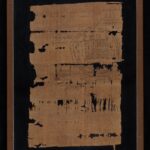| Artefact ID | 757 |
| TM ID | TM 873048 |
| Findspot (DEChriM ID) | - () | Class | Textual |
| Material | Papyrus |
| Writing medium | Sheet/roll |
| Text content | Subliterary |
| Language | Greek |
| Description | Trnka-Amrhein 2020: 87-108: Christian protective amulet with drawings. The papyrus fragment measures 17.4 cm x 26.6 cm (with an additional 2 cm of fibre), with a significantly smaller written area of 12.5 × 13.25 cm. Upper-, bottom- (approx. 11 cm) and left (approx. 4 cm) margins are preserved. Two (or three) horizontal lines of damage indicate that the fragment was folded several times. The text/design is written across the fibres; the back is blank. The design of the amulet consists of an ouroboros with an inlaid palindrome (the image is of a bearded serpent consuming its own tail) encircling an open book-roll filled with an 8x8 grid of Greek vowels. The vowels spill out beyond the book-roll on its left -, right- and bottom side. Above it, there is a bird clutching a christogram [chrism] in its beak with Jesus-monogram legs. A tabula ansata appears below the snake-design, and three blocks of text are situated to the left (bottom and top corner) and right (lower corner) of the book roll. The text presents the names of Gabriel, Michael, Remiel and Souriel as well as Solomon (in the 'ring of Solomon', upper right corner) together with the nomina sacra of Israel and θεός. The ed. pr. suggests that the phrase “seal of the living god” derives from the Apocalypse of John 7.2, and it appears also in another amulet from the 4th c.; P.Oxy LXXXII 5306 (amulet for Eulogia). The arrangement of the vowel-grid within the book-roll is singular in magical designs: it features all of the Greek vowels, and they are all repeated (differing from other designs, which feature selected vowels and/or repetition). Furthermore, contrary to the commonly shared features of amulets, this particular amulet does not explicitly name its function nor identify its wielder. The ed. pr. argues that the artefact is an applied amulet and not a magical instruction, and suggests that its closest parallel (in the form of combining text and image) is P.Oxy. VIII 1077 (amulet from the 6/7th c). |
| Selection criteria | Christian symbols/gestures/isopsephy, Nomina sacra, Biblical quote or paraphrase |
| Date from | 300 |
| Date to | 399 |
| Dating criteria | Palaeography. The ed. pr. places the amulet in the 4th c., and gives the comparanda of inter alia P.Bodmer IV (first half of the 4th c. Panopolis, containing i.a. Menander Dyscolus) and BGU IV 1092 (landlease from 372 AD; Hermoupolis). |
| Absolute/relative date | Relative date |
| Archaeological context | The provenance is unknown. The ed. pr. suggests the possibility that the amulet was cut before being sold to Chester Beatty. |
| Accession number | Dublin, Chester Beatty Library, Coptic Collection, Pap 1011. |


 Json data
Json data




